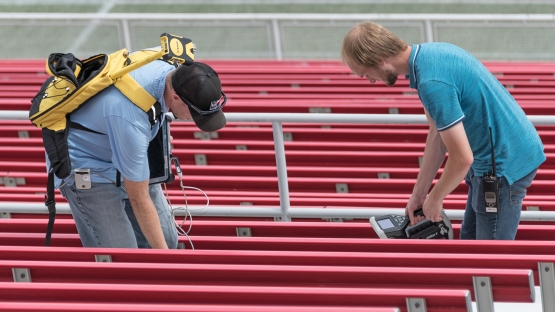A mock explosion near a hypothetical major sporting event in Las Vegas set the scene for an exercise in which the IAEA tested the adaptability of its multinational Response and Assistance Network, RANET, whose members deliver expertise and specialized equipment to assist in a response to nuclear and radiological emergencies.
In the 23-26 September 2019 exercise scenario, hosted by the US Department of Energy’s National Nuclear Security Administration (NNSA), the IAEA received a request for support to locate and recover any radioactive sources in a stadium and athlete’s village before a major sporting event. The IAEA activated RANET and dispatched to Las Vegas a Joint Assistance Team including experts from five countries and the IAEA Secretariat.
As the exercise commenced, a mock explosion was reported at a storage facility near the athlete’s village prior to the hypothetical sporting event. In the scenario, firefighters detected radiation levels many times higher than the relevant background levels of the area, indicating that radioactive sources were involved.
Authorities from the requesting country simulated issuing a further assistance request for specialized support for the response to the incident. After the Joint Assistance Team determined that they could work safely in the area, they developed and agreed on a plan with the requesting country to conduct wide-area radiation monitoring. By taking measurements nearby and downwind of the simulated explosion, the team determined that the athlete’s village and the surrounding area should be evacuated.
The team then received the next simulated assistance request to monitor radioactivity in a busy, pedestrian zone bustling with tourists. Team members were tasked with surveying radioactivity along the 3-kilometre length of the crowded public area without attracting attention or causing public alarm. The Joint Assistance Team correctly identified the single individual illicitly carrying a radioactive source.
“We developed and conducted this exercise with the IAEA to provide a more complex situation than is routinely available,” said Jared Czap, Acting Deputy Director, Office of Nuclear Incident Policy and Cooperation, NNSA. “The RANET teams responded robustly and demonstrated that RANET is a network that can effectively tailor its support to dynamic emergency conditions.”
On the final day of the exercise, the teams searched both the 35,000-seat Sam Boyd Stadium and a shopping mall’s 6,000 car parking lot, where they located all hidden radioactive sources.
“RANET’s success depends on testing and strengthening our procedures to deliver the assistance that Member States may request in an emergency,” said IAEA RANET Officer Kilian Smith. “The Las Vegas Joint Action Team exercise, hosted by NNSA, was an invaluable initiative that helps ensure that RANET is ready to handle complex emergencies.”





